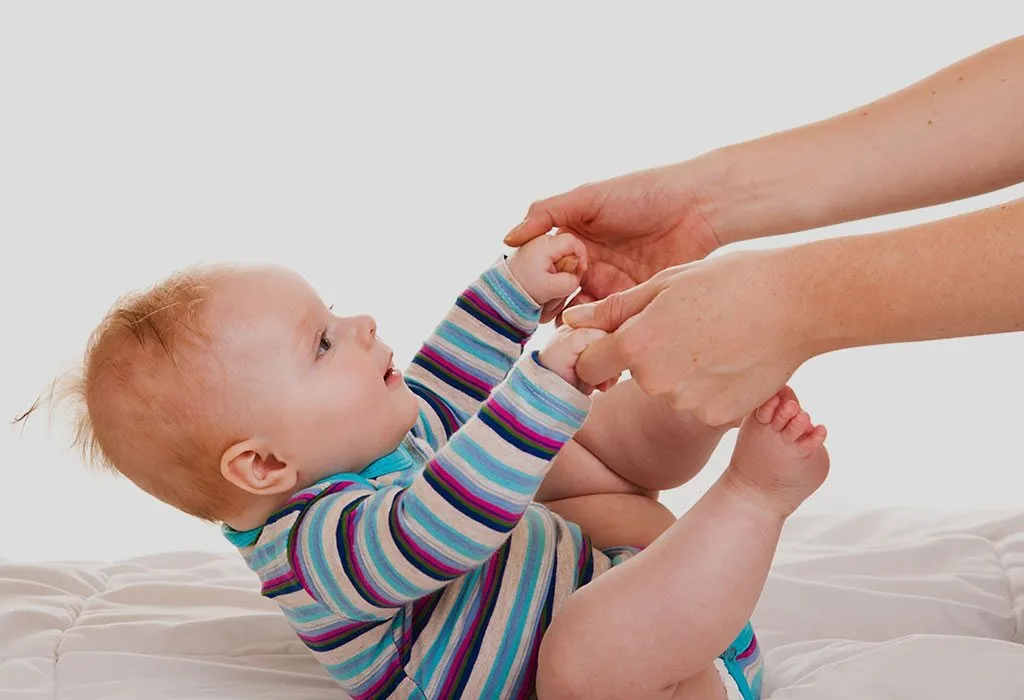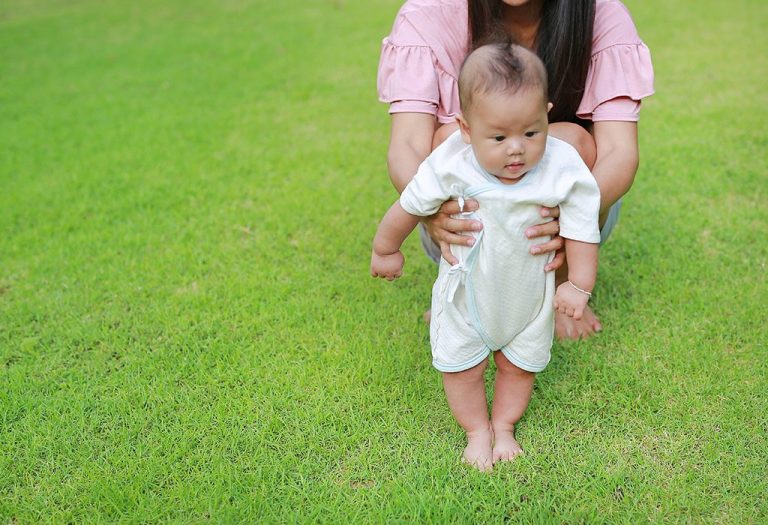When Do Babies Start Sitting?

Watching your baby reach new milestones is an exciting part of parenthood. You tend to keep track of each milestone of your baby meticulously. Once your baby becomes an expert in rolling over and holding his head up, you will want to know when he will achieve the next milestone, i.e., sitting up. Sitting means exploring and playing in a new environment for your child. Learning to sit up straight requires time and effort. As a parent, you will want to know if your baby’s development is on the right track. Let’s find out! When does a baby start sitting up?
When Do Babies Start Sitting Up?
Babies learn to sit between the ages of four and seven months. This stage gives the baby a new perspective on the world. By the time they turn eight months old, they can sit without support for a short period. When your baby starts sitting up, you should support his back. There are chances that he may lose his balance and hit his head on the floor.
The question, ‘What age do babies sit up?’, can vary widely, and no fixed timeline applies to all infants. Ideally, babies should start sitting up by 3–5 months with additional support (1). By around six months, the baby should be able to sit unassisted as he would have developed enough muscular strength in the back and neck muscles. But there are cases where the baby cannot sit without help until nine months. This generally happens when the baby spends too much time in the crib.
Signs Your Baby Is Ready to Sit
By around 4 months, your baby should be able to hold the head steady, while propped up with support (8). This is because his neck muscles will be strong enough to do so. A good way to help him improve his neck and head control is by making a game of helping him to sit upright when he is in reclining position. This can be done by holding his hands firmly and slowly helping him up. More fun can be added to this by making funny sounds or faces!
How Does a Baby Learn to Sit and Maintain Balance?
As soon as your baby learns to hold the head steady, it is a good idea to encourage him to sit up. When it comes to sitting, the development of head control is vital. Head control means holding the head centred when lying on the back. This can be developed only by giving more floor time to your baby. Keeping your little one in the baby gear for too long will hamper his ability to gain head control. This is mainly because of the semi-reclined position of most baby gears.
Unlike adults, babies use their hands, feet, and bottom for sitting. Such body awareness can be developed by giving more tummy time. Early tummy time will train your baby to use his hands as weight-bearing surfaces (3).
During this period you may notice that your baby will wobble. When a baby wobbles, new sensory information is sent to your baby’s brain from his different senses. It may be hard to let your child fall. But wobbling encourages a baby to make tiny adjustments using his hands, head positions, etc. In order to prevent your baby from falling and hurting himself, place him in padded mats or create a safe zone using pillows and blankets.
How Can You Help Your Baby to Sit Up Independently?
As a parent to a six-month-old baby, you will think of many ways to help your baby sit up. Parents can encourage their baby’s development by providing plenty of opportunities for them to practice sitting up. To teach them, help your baby develop the precursor skills for sitting upright. Helping baby sit up strengthens their core muscles and improves their balance.
When your baby can hold his head well, you can encourage him by propping him up in a sitting position in a stroller, an infant seat, or your lap. Using a stroller is also very good as it will create an interest in your baby for sitting.
What Are the Required Precursor Skills to Make Your Baby Sit Up?
Here is how you can help your baby to sit up:
- Holding the baby upright with support – When you hold a two-month-old baby upright at your shoulder, the baby tries to control the head position by making use of neck muscles. When holding the baby on the lap, first try to support the upper body, and then gradually move towards the hips.
- Give your baby tummy time – Tummy time is an excellent way of developing the back and neck muscles which are key in helping to sit up straight. Pushing forward to prop up on arms is also a great exercise to develop muscular strength (5).
- On-the-back playtime – Lying on the back and playing, kicking, etc. helps to tone up the flexor muscles.
- Rolling – This is a great way to develop his muscles of the trunk.
Another common question parents ask is, “How do you encourage a baby to sit up?” By developing games out of the above-mentioned activities, your baby could well be on the way to sitting up on his own (2).
Positions to Help Your Baby Sit Up
Once your baby demonstrates adequate ability to hold his head upright and shows the precursor skills, you could use the following positions to help him sit up independently:
- Sitting on your lap this is acquired ideally at the age of 3-6 months. Move your hand’s grip on the baby’s torso when he sits on your lap. Start from the upper part and slowly progress towards the hips.
- By 4 and 5 months, you can make your babysit on the floor between your legs. This is an easy way to let the baby explore sitting while feeling reassured that he is safely sandwiched between your legs.
- In the above age group, a bumbo chair can prove quite helpful. By placing toys on the tray table, he may lean to grab and play with the toys, so sitting up becomes a necessary skill for them. It is important to create the need for babies to develop skills like these.
- The tip of a laundry basket or box can serve as an alternative to the bumbo chair. But care should be taken to provide adequate support and attention when doing this.
- Surround your baby with pillows provide a freely available padded surrounding to practice sitting. Care should be taken that the pillows do not slide away easily. A boppy pillow is a commercially available alternative to using head pillows.
- Tripod sitting position this is the babysitting position when the baby sits using his arms vertically on either side as support. A cushion or pillow may be used in front to keep toys on his eye level to encourage him to sit up.
What Can You Do If Your Baby Doesn’t Sit Up?
If your baby is unable to sit upright with support by the end of nine months, please consult your doctor. Keep in mind that babies develop differently. Learning to hold the head steady and sitting up straight is key to achieving more complex future milestones like standing and walking.
What’s Next After Your Baby Starts Sitting Up?
Once your baby starts sitting confidently, he may begin to lunge his body forward and balance on hands and knees. The baby can also start crawling between the age of 7 and 10 months (6). Remember that your child will be extremely curious at this stage so childproofing your home is very important (7).
Some Safety Tips to Follow Before Your Baby Learns to Sit Up
Before your baby begins to sit up, ensuring their environment is safe and secure is crucial (4). Here are some essential safety tips to keep in mind:
- Always supervise your baby closely when they are practising sitting up.
- Use a safe, supportive surface, such as a firm cushion or play mat, to prevent falls.
- Keep hazardous objects, such as small toys, out of reach to prevent choking.
- Avoid placing your baby on elevated surfaces, such as beds or sofas, without supervision.
- Ensure that any baby gear, such as high chairs or strollers, is used according to the manufacturer’s instructions and is in good condition.
- Create a safe play area by removing potential hazards and securing furniture and electronics.
When to Consult the Doctor?
While most babies learn to sit up on their own without any issues, there are times when it’s essential to consult a doctor to ensure your baby’s development is on track. Do consult a doctor for the following reasons:
- If your baby has yet to start sitting up by nine months.
- If your baby seems floppy or has low muscle tone.
- If your baby consistently favours one side of their body.
- If your baby seems unusually stiff or has difficulty moving their arms or legs.
- If your baby shows signs of pain when trying to sit up.
- If you have any concerns about your baby’s development or mobility.
FAQs
1. Can premature babies start sitting up at same age as full-term babies?
Premature babies may need more time to develop the muscle strength and coordination to sit up independently. It is important to give them the extra time they need to catch up.
2. Are there specific exercises you can do with your baby to promote sitting skills?
Yes, there are several exercises you can do with your baby to promote sitting skills. Tummy time is a great way to strengthen your baby’s neck, back, and core muscles, essential for sitting up. You can also gently help your baby in a sitting position and support them as they practice sitting on their own.
The journey from lying down to sitting up is a significant milestone in your baby’s development, marking the beginning of greater mobility and independence. While the age at which babies start sitting up can vary, it is a natural progression that can be supported through activities promoting muscle strength, balance, and coordination. Your baby will learn to sit up in no time if you provide them with healthy food, lots of rest, and lots of encouragement.
References/Resources:
1. Baby Milestones – When Babies Sit Up, Roll Over and Crawl; Help Me Grow; https://helpmegrowmn.org/HMG/HelpfulRes/Articles/BabyMilestones/index.html
2. Your baby’s development from 2 to 12 months; NHS inform; https://www.nhsinform.scot/ready-steady-baby/early-parenthood/your-baby-s-development-from-2-to-12-months/
3. When Will Baby Sit Up On Their Own?; Pathways.org; https://pathways.org/baby-sitting-on-their-own/
4. Home Safety for Infants and Toddlers; Nationwide Children’s Hospital; https://www.nationwidechildrens.org/family-resources-education/health-wellness-and-safety-resources/helping-hands/home-safety-for-infants-and-toddlers
5. Hewitt. L, Kerr. E, Stanley. R. M, Okely. A. D; Tummy Time and Infant Health Outcomes: A Systematic Review; American Academy of Pediatrics; https://publications.aap.org/pediatrics/article/145/6/e20192168/76940/Tummy-Time-and-Infant-Health-Outcomes-A-Systematic?autologincheck=redirected; June 2020
6. Developmental Milestones: 7 Months; American Academy of Pediatrics; https://www.healthychildren.org/English/ages-stages/baby/pages/Developmental-Milestones-7-Months.aspx
7. Childproofing Your Home; National Safety Council; https://www.nsc.org/community-safety/safety-topics/child-safety/childproofing-your-home
8. Movement Milestones: Babies 4 to 7 Months; American Academy of Pediatrics; https://www.healthychildren.org/English/ages-stages/baby/Pages/Movement-4-to-7-Months.aspx
Also Read:
Babies Start Rolling Over
When do Babies Start Standing
Help your Baby to Sit Up on His Own
Was This Article Helpful?
Parenting is a huge responsibility, for you as a caregiver, but also for us as a parenting content platform. We understand that and take our responsibility of creating credible content seriously. FirstCry Parenting articles are written and published only after extensive research using factually sound references to deliver quality content that is accurate, validated by experts, and completely reliable. To understand how we go about creating content that is credible, read our editorial policy here.


























